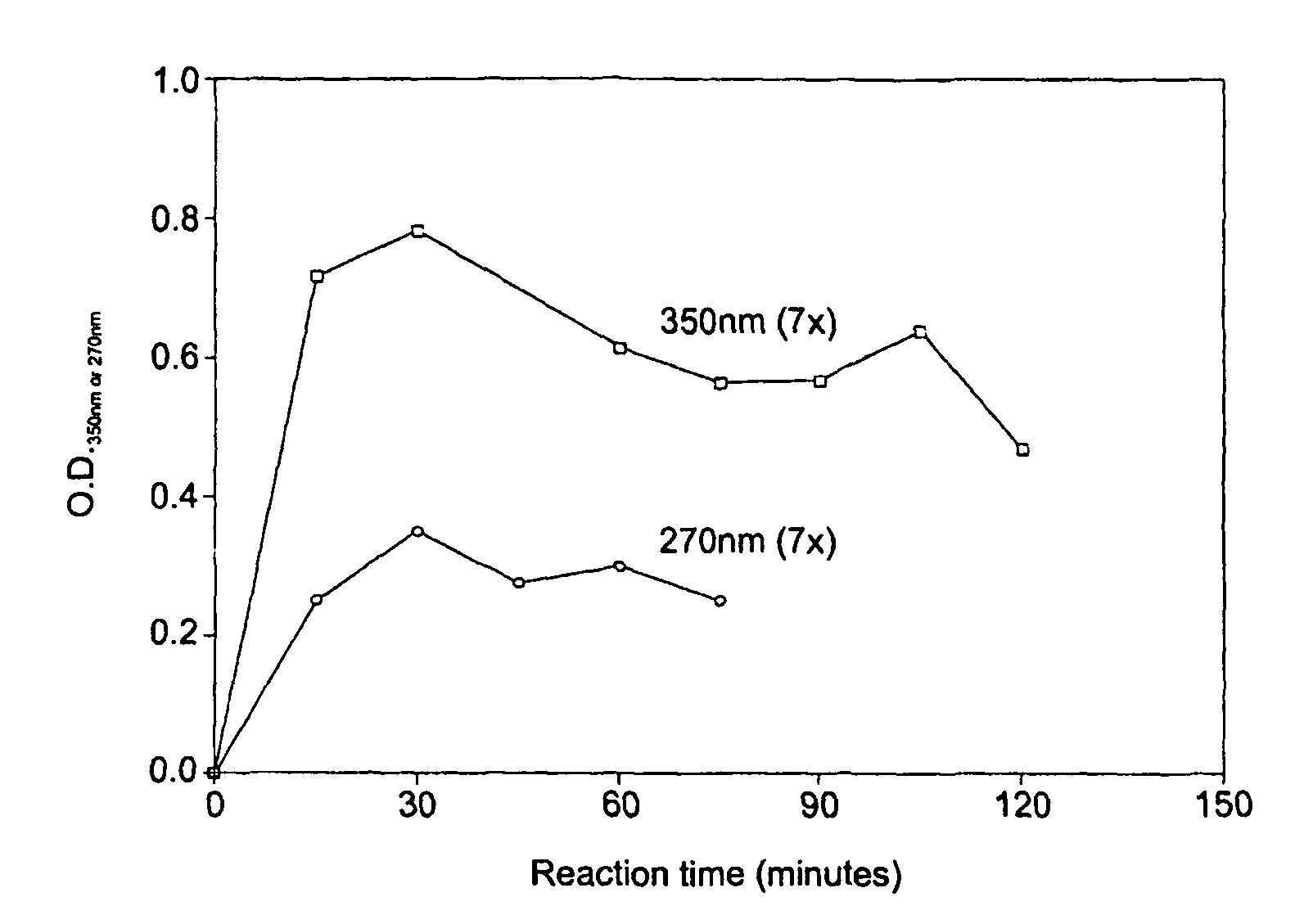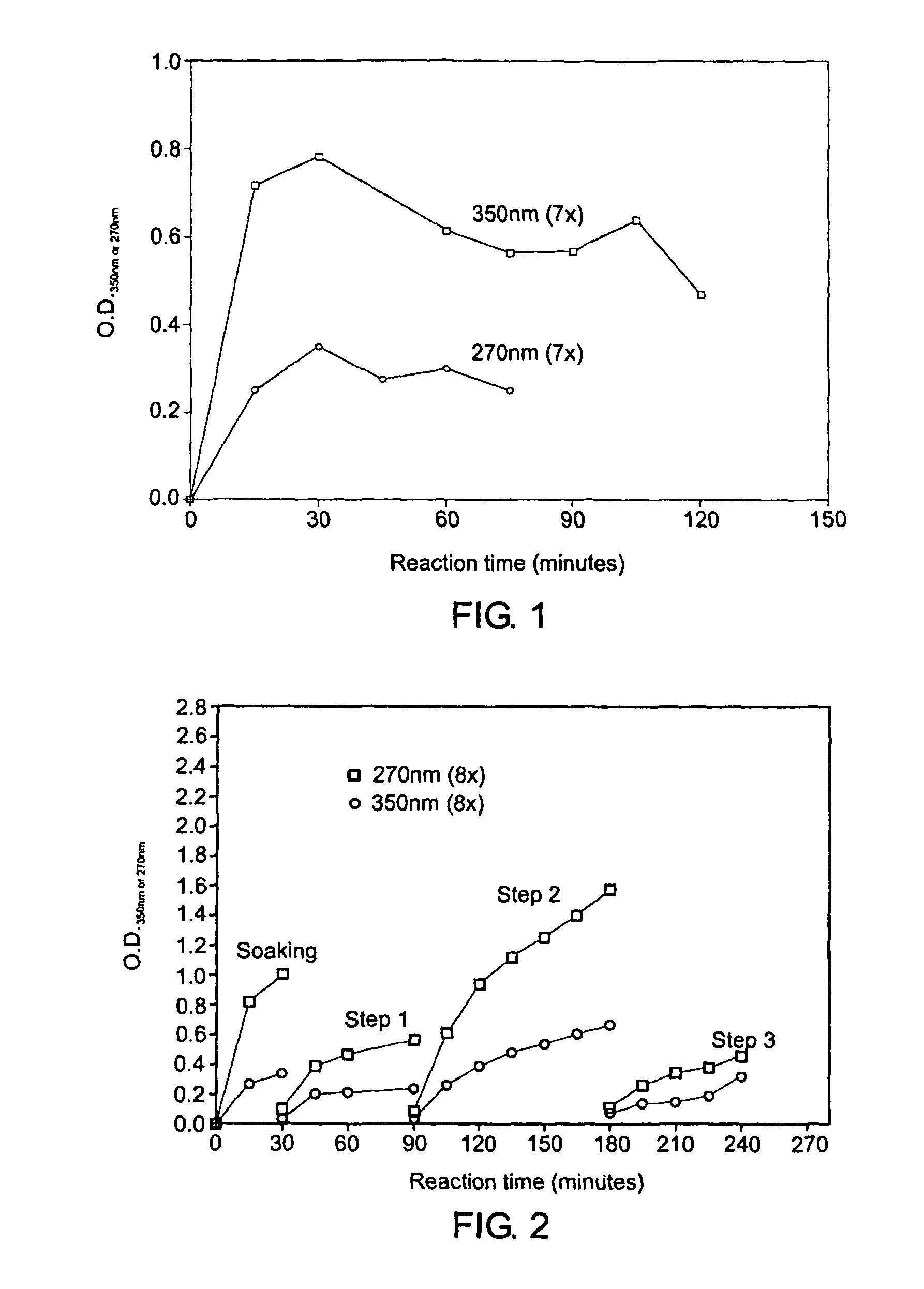Extraction of hemp fibers
a technology of hemp fibers and processing methods, applied in the field of extraction of hemp fibers, can solve the problems of polluting the water of the process, affecting the dew-retting, and no guaranty of favorable conditions, and achieve the effect of reducing the concern of contaminating enzymes
- Summary
- Abstract
- Description
- Claims
- Application Information
AI Technical Summary
Benefits of technology
Problems solved by technology
Method used
Image
Examples
example 1
Extraction of Fiber from Decorticated Bast Skin of Canadian Hemp
[0032]Ten grams of decorticated hemp bast skin of Canadian hemp TAB was pre-treated by agitation in 200 ml of an aqueous solution containing 0.8% (w / v) of tri-sodium citrate at 85° C. for 3 hr. Release of material into solution was monitored via optical density (O.D.) measured by UV-Vis spectroscopy at 270 nm and 350 nm (FIG. 1). The dilution factor to yield the appropriate O.D. is shown in parenthesis in FIG. 1. Pre-treated fiber was then rinsed twice with water.
[0033]Recovered fiber was treated in 200 ml of an aqueous solution containing the enzyme pectinase (Novozyme Pectinase Ultra SP-L, 1040 U) and 5 mM sodium citrate, with pH around 4.5, at 45° C. After 1 hr, the enzyme solution was recovered for recycling. The fiber was rinsed twice. The fiber has a beige color ready to be separated into finer fiber.
example 2
Extraction of Fiber from Decorticated Bast Skin of Chinese Hemp
[0034]Soaking: Ten grams of decorticated hemp bast skin was soaked in 200 ml of water at 80° C. for 30 min.
[0035]Step 1: The fiber was then agitated in 200 ml of a solution containing 0.8% (w / v) of tri-sodium citrate at 80° C. for 1 hr. Treated fiber was rinsed twice with tap water.
[0036]Step 2: Step 1 was followed by agitation in 200 ml of an aqueous solution containing 0.8% (w / v) of tri-sodium citrate and 0.2% (w / v) of NaOH at 80° C. for 1.5 hr. Treated fiber was rinsed twice with water.
[0037]Step 3: Recovered fiber was treated in 200 ml of a solution containing the enzyme pectinase (Novozyme Pectinase Ultra SP-L, 1040 U) and 5 mM sodium citrate, with pH around 4.5, at 45° C. After 1 hr, the enzyme solution was recovered for recycling. The fiber was rinsed twice. The fiber was ready to be separated into finer fiber. Release of materials into each of the solutions was monitored via O.D. measured by UV-Vis spectroscopy a...
example 3
Softening of Hemp Fiber
[0038]After enzymatic treatment from Examples 1 and 2, wet hemp fiber (5 g) was washed with 120 ml of isopropanol for 5 min to produce a colored isopropanol solution. The colored isopropanol solution was decanted, and the fiber was allowed to air-dry. The fiber is softer than those without the isopropanol treatment.
PUM
| Property | Measurement | Unit |
|---|---|---|
| temperature | aaaaa | aaaaa |
| temperature | aaaaa | aaaaa |
| temperature | aaaaa | aaaaa |
Abstract
Description
Claims
Application Information
 Login to View More
Login to View More - R&D
- Intellectual Property
- Life Sciences
- Materials
- Tech Scout
- Unparalleled Data Quality
- Higher Quality Content
- 60% Fewer Hallucinations
Browse by: Latest US Patents, China's latest patents, Technical Efficacy Thesaurus, Application Domain, Technology Topic, Popular Technical Reports.
© 2025 PatSnap. All rights reserved.Legal|Privacy policy|Modern Slavery Act Transparency Statement|Sitemap|About US| Contact US: help@patsnap.com


